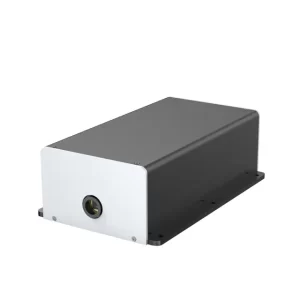
1. Introduction: Advancements in Single Photon Detection with Lontenoe’s InGaAs Array
Single photon detection has emerged as a cornerstone technology across a myriad of contemporary scientific and industrial disciplines. Its significance spans from the foundational elements of quantum technologies, such as quantum key distribution and quantum computing, to practical applications in light detection and ranging (LiDAR), advanced biomedical imaging, and high-speed optical communications. A persistent challenge in these fields involves the reliable detection of extremely weak light signals, particularly within the near-infrared (NIR) spectrum, where conventional detectors often fall short in terms of sensitivity and noise performance.
Addressing these critical demands, the Lontenoe InGaAs Single Photon 4×4 Array Detector Assembly presents a sophisticated solution. Classified as a “Photodiode module”, this cutting-edge system is engineered for high-performance, spatially resolved single-photon detection. Its core capability lies in its ability to effectively detect weak light signals within the near-infrared band, specifically spanning the range of 0.95 to 1.65 µm. The assembly is meticulously constructed from several interconnected modules, including a detector module, a voltage inverter module, a refrigeration module, and a signal control module. These components are seamlessly integrated with a 4×4 InGaAs single photon avalanche photodiode (SPAD) chip and a CMOS active passive quenching circuit chip, employing reverse soldering for optimal performance.
The selection of the 0.95-1.65 µm spectral response band is a deliberate design choice, strategically positioning the detector for broad applicability across vital sectors. This specific wavelength range is paramount because it encompasses several crucial windows for various applications. For instance, it includes the 1.3 µm and 1.55 µm wavelengths, which are fundamental to telecommunications due to minimal optical fiber loss, enabling advancements in fiber-optic communication networks and secure quantum key distribution protocols. Furthermore, many high-power laser applications, such as LiDAR and ranging systems, operate within this band because light at these wavelengths is absorbed by the eye’s aqueous humor before reaching the retina, rendering it inherently safer than visible or shorter-wavelength NIR lasers. In biomedical imaging, light within this range penetrates biological tissues more deeply than visible light, owing to lower absorption by hemoglobin and water, thereby facilitating advanced non-invasive diagnostic techniques. Moreover, these wavelengths exhibit reduced susceptibility to scattering by atmospheric particles like fog, haze, smoke, and dust, a characteristic critical for outdoor sensing and communication systems. This wide-ranging utility across diverse and essential domains underscores the detector’s strategic importance and significant market potential.
2. Architectural Overview and Core Operating Principles
The Lontenoe InGaAs Single Photon 4×4 Array Detector Assembly is a highly integrated system, meticulously designed for optimal performance in single-photon detection. At its heart lies the detector module, which encapsulates the InGaAs SPAD array, serving as the primary sensing element. Complementing this, the voltage inverter module is responsible for supplying the precise high bias voltage required for the detector’s operation in Geiger mode. A critical component for achieving high sensitivity and low noise is the refrigeration module, which actively cools the SPAD array. This cooling is particularly vital for InGaAs detectors, as their narrower bandgap makes them inherently more prone to thermally generated carriers, which manifest as dark counts. By significantly reducing the operating temperature, the refrigeration module effectively minimizes these noise contributions, thereby enhancing the detector’s signal-to-noise ratio. The signal control module acts as the central interface, managing detector operation, configuring parameters, and facilitating data readout.
The core of the detector’s sophisticated performance is attributed to the integration of a 4×4 InGaAs single photon avalanche photodiode (SPAD) chip with a CMOS active passive quenching circuit chip, connected via reverse soldering. The 4×4 array format is instrumental, providing inherent spatial resolution and enabling parallel detection across 16 independent pixels, which is crucial for imaging and multi-point sensing applications. The detector operates in “Geiger working mode”, a principle where the photodiode is biased above its breakdown voltage. When a single photon strikes the active area, it triggers an avalanche of charge carriers, generating a macroscopic electrical pulse that is easily detectable. This high internal gain mechanism allows for the detection of “weak light signal”, effectively amplifying the minuscule energy of a single photon into a measurable event.
The “CMOS active passive quenching circuit chip” is pivotal in managing the SPAD’s operation. After an avalanche event, the SPAD must be rapidly reset to its quiescent state to enable subsequent photon detection. Quenching circuits achieve this by quickly reducing the bias voltage below the breakdown point, then restoring it. The “active passive” approach, likely an optimized active quenching mechanism, ensures rapid quenching and resetting of the SPAD after an avalanche. This rapid recovery is paramount for achieving high photon count rates and minimizing dead time. The integration of this quenching circuit in CMOS technology allows for miniaturization, lower power consumption, and the potential for on-chip signal processing, which is highly advantageous for a multi-pixel array. Furthermore, the use of “reverse soldering” (also known as flip-chip bonding) is an advanced packaging technique that directly connects the SPAD array to the CMOS readout integrated circuit (ROIC). This method significantly minimizes interconnect lengths, thereby reducing parasitic capacitance and inductance. In the realm of single-photon detection, where signals are extremely minute and fast, minimizing these electrical parasitics is critical for achieving high operating speeds, maintaining low noise levels, and preserving signal integrity. This directly contributes to the detector’s ability to operate at high effective pixel rates and achieve minimal dead times. This level of sophisticated integration represents a mature and high-performance design, distinguishing it from simpler, less integrated solutions.
The explicit inclusion of a “refrigeration module” underscores a fundamental aspect of the detector’s design philosophy: a commitment to minimizing noise. InGaAs, due to its relatively narrower bandgap compared to silicon, is inherently more susceptible to thermally generated carriers. These carriers can spontaneously trigger avalanche events, leading to spurious detections known as Dark Count Rates (DCR). Cooling the detector significantly suppresses these thermal carriers, thereby drastically reducing the DCR to a specified ≤10KHz. A low DCR is of paramount importance for achieving a high signal-to-noise ratio, particularly when detecting “weak light signals” in photon-starved applications such as long-range imaging or quantum communication. The active cooling mechanism is not merely a supplementary feature but a necessity for realizing the specified low noise performance in the NIR, making the detector suitable for the most demanding applications.
3. Key Features: Unpacking the Detector’s Capabilities
The Lontenoe InGaAs Single Photon 4×4 Array Detector Assembly is equipped with a suite of features that collectively define its advanced capabilities and versatility across various applications.
The detector’s spectral response band of 0.95-1.65 µm is a fundamental characteristic that enables its utility in diverse NIR applications, as previously discussed, including telecommunications, eye-safe laser systems, and biomedical diagnostics.
A significant advantage of this array detector is its pixel independence and free operation. Each of the 16 pixels within the 4×4 array functions autonomously, meaning that a detection event in one pixel does not interfere with the operation of others. This independent operation facilitates true spatial resolution, enabling simultaneous detection at multiple points and parallel processing of photon events. This capability is critical for applications requiring imaging or multi-point sensing, offering a distinct advantage over single-pixel detectors or arrays where pixel interactions might limit performance.
The detector’s ability to discern a pixel detectable weak photon signal is a direct consequence of its Geiger mode operation and the high avalanche gain achieved. This allows for the reliable detection of extremely low light levels, down to single photons, which is essential for photon-starved environments or long-distance applications.
The management of detector performance is further enhanced by its adjustable deadtime and adjustable threshold for detecting Geiger avalanche signals. Deadtime refers to the brief period following a photon detection during which a SPAD pixel is unable to detect another photon. The ability to adjust this deadtime over a range of 100ns to 1000ns is a crucial optimization parameter. A shorter deadtime allows for higher maximum photon count rates, which is beneficial for applications with high photon flux. Conversely, a longer deadtime can be employed to reduce afterpulsing—a phenomenon where a spurious detection occurs shortly after a true event due to trapped charges—thereby improving data fidelity, particularly in sensitive quantum optics experiments or fluorescence lifetime measurements. The adjustable threshold for avalanche signals provides users with the flexibility to fine-tune the detector’s sensitivity and noise rejection. A lower threshold increases the likelihood of detecting very weak signals but may also admit more noise (such as dark counts or optical crosstalk), while a higher threshold filters out smaller noise events, potentially at the cost of missing the faintest photon signals. This level of user control over fundamental operating parameters signifies a highly flexible and professional-grade instrument, empowering researchers and engineers to optimize performance for specific experimental conditions and application requirements.
Furthermore, the detector supports an integrated TDC function, with direct output of digital timestamps. A Time-to-Digital Converter (TDC) is a circuit that precisely measures the arrival time of each detected photon. The “integrated” nature of this function simplifies system design for the end-user, eliminating the need for external, often costly, timing electronics. The “direct output of digital timestamps” is indispensable for a variety of time-resolved measurements, including time-correlated single photon counting (TCSPC), which is fundamental to fluorescence lifetime imaging in biomedical research and quantum optics experiments. It is also critical for time-of-flight measurements, such as those used in LiDAR and ranging applications, where precise temporal information is converted into distance data.
These features collectively translate into significant practical advantages. The adjustable deadtime and independent pixels contribute to high throughput, allowing for high effective count rates. The broad spectral range and adjustable parameters provide remarkable versatility, enabling adaptation to a wide array of diverse applications. The integrated TDC is crucial for precision timing, facilitating advanced time-resolved measurements. Finally, the 4×4 array with independent pixels offers inherent spatial resolution, providing imaging capabilities that are essential for many sensing and surveillance applications.
The integrated TDC function, particularly when coupled with the “10 Gigabit Ethernet UDP protocol, TDC digital signal timestamp output” of the GD-NIR4100S-TDC model, elevates this detector beyond basic photon counting. This capability is foundational for time-correlated measurements, which are the backbone of applications like fluorescence lifetime imaging (FLIM) in biomedical diagnostics, 3D mapping and ranging via time-of-flight LiDAR, and sophisticated quantum optics experiments, such as those measuring photon correlations for quantum entanglement studies. The 10 Gigabit Ethernet interface is crucial for efficiently transferring the large volume of timestamped data generated by a 4×4 array operating at high photon rates. This high bandwidth ensures the system can handle real-time data streams for demanding applications, preventing data bottlenecks. By integrating the TDC internally, Lontenoe simplifies the overall system design for users, reducing the need for external, often expensive, timing electronics and streamlining data acquisition. This positions the GD-NIR4100S-TDC model as a critical component for cutting-edge research and commercial applications that demand precise temporal information, making it a powerful tool for advancing fields like quantum technology and advanced sensing.
4. In-Depth Performance Analysis: A Closer Look at Specifications
A detailed examination of the Lontenoe InGaAs Single Photon 4×4 Array Detector Assembly’s technical parameters provides a comprehensive understanding of its performance capabilities and suitability for various applications. The following table summarizes these critical specifications for both available models, GD-NIR4100S and GD-NIR4100S-TDC, along with expert commentary on their significance.
Technical Parameter | GD-NIR4100S Value | GD-NIR4100S-TDC Value | Expert Commentary & Significance |
Device type | InGaAs SAPD Array | InGaAs SAPD Array | Confirms the core technology as Indium Gallium Arsenide Single Photon Avalanche Photodiode, indicating suitability for NIR detection and inherent spatial resolution due to the array format. |
Array size | 4×4 | 4×4 | Specifies the detector’s spatial dimension, comprising 16 individual pixels. This is crucial for imaging, multi-point sensing, and increasing the overall photon collection area. |
Pixel center distance | 100µm x 100µm | 100µm x 100µm | Defines the pitch between the centers of adjacent pixels, directly indicating the spatial resolution capability of the array. A 100µm pitch is appropriate for many imaging and ranging applications. |
Pixel spacing | ≤20µm | ≤20µm | Refers to the physical gap between the active detection areas of adjacent pixels. A small spacing (≤20µm) suggests a high fill factor, which maximizes the active detection area and minimizes inactive or “dead” space between pixels, improving overall photon collection efficiency. |
PDE Photon detection efficiency PDE | 10%~25% | 10%~25% | **Photon Detection Efficiency:**Represents the probability that an incident photon will be detected. While the 10-25% range may appear modest compared to some visible-range detectors, it is a respectable efficiency for InGaAs SPADs operating in the specified NIR band, where achieving high PDE is technically challenging. This efficiency is crucial for sensitivity in photon-starved applications and for maximizing signal strength over long distances. The range indicates potential tunability or typical variation across devices. |
DCR Dark count rate DCR | ≤10KHz | ≤10KHz | **Dark Count Rate:**The rate of spurious detection events occurring in the absence of incident photons. A low DCR (≤10KHz for the entire 4×4 array, equating to approximately 625 Hz per pixel) is absolutely critical for achieving a high signal-to-noise ratio, especially when detecting very low light levels. The dedicated refrigeration module directly contributes to achieving this low noise floor by minimizing thermally generated carriers. |
Post-impulse probability | ≤20% | ≤20% | The likelihood of a spurious detection (an “afterpulse”) occurring shortly after a true photon event. A low value (≤20%) is vital for maintaining data integrity and accuracy, particularly at higher photon count rates or when operating with shorter dead times, as afterpulses can corrupt timing or intensity measurements. |
Dead time | 100ns~1000ns Adjustable | 100ns~1000ns Adjustable | The minimum time interval during which a pixel cannot detect a second photon after a preceding detection event. The adjustability of this parameter allows users to optimize the detector’s performance. A shorter dead time maximizes the photon throughput and allows for higher maximum count rates, while a longer dead time can significantly reduce the probability of afterpulsing, improving data quality in sensitive applications. This flexibility enables tailoring the detector to specific application requirements. |
Effective pixel rate | 100% | 100% | Indicates that all 16 pixels are fully functional and capable of contributing to the overall detection capability without being bottlenecked by readout or processing limitations. This ensures maximum effective detection area and efficient parallel processing of photon events. |
Control interface | Serial port (baud rate 115200bps) | Serial port (baud rate 115200bps) | A standard and reliable interface used for configuring detector parameters such as deadtime, threshold settings, and operating voltage. This provides a common method for device control and integration into larger systems. |
Data interface | Standard 3.3 VTTL level output | 10 Gigabit Ethernet UDP protocol, TDC digital signal timestamp output | **This is a crucial differentiator between the two models.**The GD-NIR4100S offers a straightforward digital pulse output, suitable for basic photon counting applications where only the occurrence of a photon event is required. In contrast, the GD-NIR4100S-TDC provides high-bandwidth, timestamped data via a 10 Gigabit Ethernet UDP protocol. This capability is essential for time-resolved applications like LiDAR, time-correlated spectroscopy, and quantum communication, as it directly outputs precise timing information for each detected photon, simplifying data acquisition for complex measurements. UDP (User Datagram Protocol), being connectionless, offers lower latency, which is often preferred for real-time data streaming in scientific instruments. |
Working temperature | -40°C~+55°C | -40°C~+55°C | A wide operating temperature range signifies the detector’s robustness and suitability for deployment in diverse and demanding environmental conditions, including industrial and outdoor settings where temperature fluctuations are common. |
Storage temperature | -40°C~+70°C | -40°C~+70°C | A broad storage temperature range further confirms the detector’s ruggedness and ability to withstand non-laboratory environments during transport or inactive periods. |
Power consumption | ≤15W | ≤15W | A relatively low power draw for a cooled array detector. This is beneficial for portable, battery-operated, or power-constrained systems, and it also contributes to simplified thermal management within integrated systems. |
The primary distinction between the GD-NIR4100S and GD-NIR4100S-TDC models lies in their data interfaces. The GD-NIR4100S, with its Standard 3.3 VTTL output, is well-suited for basic photon counting applications where the primary requirement is simply to register the presence of a photon event through a digital pulse. This model offers simplicity and compatibility with common digital logic systems. Conversely, the GD-NIR4100S-TDC model is specifically engineered for high-performance, time-resolved applications. Its integrated Time-to-Digital Converter (TDC) provides precise timing information for each photon event, a capability that is crucial for time-of-flight measurements (e.g., in LiDAR and ranging), fluorescence lifetime imaging, and quantum communication. The inclusion of a 10 Gigabit Ethernet interface ensures high bandwidth for efficiently transferring the large volumes of timestamped data generated by the 4×4 array, which is essential for maintaining high throughput in these demanding applications. UDP, as a connectionless protocol, offers lower latency, which is often preferred for real-time data streaming in scientific instruments. This clear differentiation in data output capabilities allows Lontenoe to cater to a broader market, ranging from general photon counting to highly specialized time-resolved photonics, indicating a strategic and well-considered product line development.
The wide working temperature range (-40°C to +55°C) and storage temperature range (-40°C to +70°C), combined with a relatively low power consumption (≤15W), collectively indicate that this detector is designed for more than just controlled laboratory environments. Many sensitive optical detectors necessitate climate-controlled conditions for optimal performance. However, this broad temperature tolerance points to robust engineering, making the Lontenoe detector suitable for deployment in challenging outdoor conditions, such as those encountered in military applications, environmental monitoring, or industrial automation, where significant temperature fluctuations are common. This resilience directly supports its utility in applications like “distance measurement through fog, haze, smoke and dust” and “near-infrared laser warning and laser ranging”, which frequently occur in uncontrolled, harsh environments. Furthermore, the efficient power consumption of ≤15W for a cooled array detector is a significant advantage. This attribute is crucial for portable, battery-operated systems, such as those integrated into unmanned aerial vehicles (UAVs) for LiDAR mapping, or handheld gas detectors, as well as for remote installations where power resources are limited. Lower power consumption also translates to less heat dissipation, simplifying the overall thermal management requirements of the system into which the detector is integrated. These practical engineering considerations significantly enhance the detector’s market appeal beyond pure research laboratories, enabling its seamless integration into real-world industrial and defense systems.
5. Diverse Applications Across Scientific and Industrial Domains
The Lontenoe InGaAs Single Photon 4×4 Array Detector Assembly is designed to serve a broad spectrum of applications, leveraging its unique combination of single-photon sensitivity, spatial resolution, and precise timing capabilities within the near-infrared spectrum. The diverse range of “Application Direction” underscores the detector’s foundational technological versatility. The common thread across these seemingly disparate fields is the critical need for highly sensitive, often time-resolved, and spatially aware detection in the near-infrared.
One prominent application area is **distance measurement through fog, haze, smoke and dust, etc.**. In these challenging atmospheric conditions, near-infrared wavelengths penetrate obscurants more effectively than visible light. The detector’s single-photon sensitivity is crucial here, enabling long-range detection even when the signal is severely attenuated. The 4×4 array format could further enhance capabilities by enabling 3D mapping or imaging through these conditions, providing spatial context to the distance measurements.
For near-infrared laser warning and laser ranging, the detector’s capabilities are particularly well-suited. The use of NIR lasers in these applications is often preferred due to their eye-safe nature. The detector’s high sensitivity allows for the detection of extremely weak scattered laser pulses over long distances, which is vital for effective warning systems and precise ranging. The integrated TDC function, especially in the GD-NIR4100S-TDC model, is critical for accurate time-of-flight measurements, directly translating into precise distance determination for LiDAR systems. This positions the detector as a key component for autonomous vehicles, defense systems, and various industrial automation tasks.
In the realm of close range space laser communication, the detector addresses the demanding requirements of weak signal reception and high data rates. Its single-photon sensitivity is indispensable for receiving extremely faint optical signals transmitted from distant spacecraft, where photons are scarce. The 10 Gigabit Ethernet interface and TDC capabilities of the GD-NIR4100S-TDC model are vital for high-speed, time-resolved data reception, ensuring efficient communication links for advanced optical communication systems.
Long range single photon imaging benefits significantly from this detector. The application demands both high sensitivity for imaging in extremely low-light conditions or over extended distances, and spatial resolution to form coherent images. The 4×4 array format provides this crucial spatial information, while the single-photon sensitivity allows for image reconstruction even from very few detected photons. The NIR spectral range is advantageous for covert operations, as it is invisible to the human eye, or for specific material analysis based on their unique NIR spectral signatures.
Finally, the detector finds utility in gas detection and biomedical imaging. For gas detection, the specified NIR band (0.95-1.65 µm) aligns with the characteristic absorption lines of various gases, such as methane, carbon dioxide, and water vapor, enabling precise absorption spectroscopy for environmental monitoring or industrial process control. In biomedical imaging, the ability of NIR light to penetrate biological tissues more deeply than visible light, due to lower absorption by hemoglobin and water, is exploited. The detector’s capacity to detect single photons in this range enables advanced techniques like fluorescence lifetime imaging (when combined with the TDC functionality) or diffuse optical tomography, facilitating deeper tissue analysis with minimal invasiveness. This indicates its utility in critical areas of environmental monitoring and advanced medical diagnostics.
This comprehensive application list demonstrates that Lontenoe has engineered a highly versatile and robust detector that serves as a critical enabling technology across multiple high-growth and strategic scientific and industrial domains. This indicates a strong market position and considerable potential for significant impact in advancing next-generation technologies.
6. Conclusion: The Lontenoe InGaAs Detector’s Impact and Future Prospects
The Lontenoe InGaAs Single Photon 4×4 Array Detector Assembly represents a significant advancement in the field of near-infrared single-photon detection. Its core technological strengths lie in its sophisticated architecture, featuring a 4×4 InGaAs single photon avalanche photodiode (SPAD) array operating in Geiger mode, seamlessly integrated with a CMOS active passive quenching circuit via reverse soldering, and complemented by an essential refrigeration module.
The detector exhibits superior performance metrics, including a respectable Photon Detection Efficiency (PDE) of 10-25% in the challenging NIR band, a low Dark Count Rate (DCR) of ≤10KHz, and a manageable post-impulse probability of ≤20%. Crucially, its adjustable dead time (100ns-1000ns) and adjustable threshold provide users with unparalleled control to optimize performance for specific application demands, balancing photon throughput with data fidelity. The versatility offered by the two distinct models, particularly the advanced capabilities of the GD-NIR4100S-TDC variant with its integrated Time-to-Digital Converter (TDC) and 10 Gigabit Ethernet data interface, positions it for the most demanding time-resolved applications. Furthermore, its robust design, evidenced by a wide operating temperature range of -40°C to +55°C and low power consumption of ≤15W, ensures reliable operation in diverse and challenging environmental conditions beyond the laboratory.
This detector is poised to accelerate advancements across numerous strategic fields. In LiDAR and ranging, its sensitivity and precise timing will enable longer-range, higher-resolution 3D mapping and more effective laser warning systems. For quantum communication, its single-photon detection capabilities and high-speed data interface are fundamental to developing more secure and efficient quantum key distribution networks. In medical diagnostics, the detector will facilitate deeper, non-invasive imaging and advanced spectroscopic techniques. Its utility in environmental sensing will enhance gas detection capabilities, while its ruggedness and performance will contribute to critical defense applications.
In conclusion, the Lontenoe InGaAs Single Photon 4×4 Array Detector Assembly stands as a testament to Lontenoe’s contribution to pushing the boundaries of single-photon detection technology in the near-infrared spectrum, providing a powerful and versatile tool for next-generation scientific and industrial innovations.





